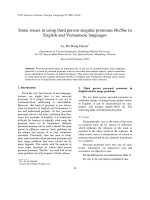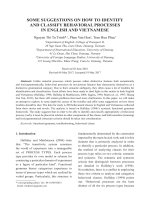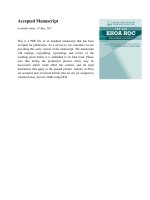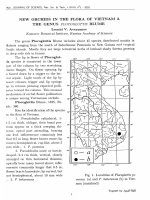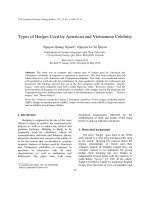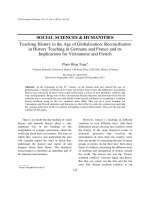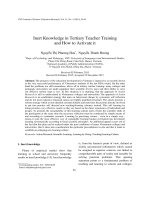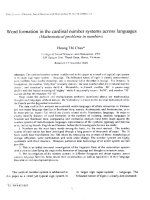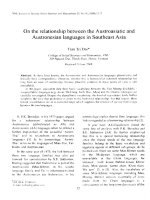DSpace at VNU: Ownership changes in Vietnamese banking system and their impacts Bai 6.N.Thanh.final
Bạn đang xem bản rút gọn của tài liệu. Xem và tải ngay bản đầy đủ của tài liệu tại đây (438.14 KB, 11 trang )
VNU Journal of Science, Economics and Business 27 (2011) 121-129
Ownership changes in Vietnamese banking system and
their impacts
Dr. Nguyen Ngoc Thanh1,*, Nguyen Tuan Hung2
1
Faculty of Political Economy, University of Economics and Business, Vietnam National University, Hanoi,
144 Xuan Thuy, Cau Giay District, Hanoi, Viet Nam
2
Academy of Banking, 12 Chua Boc Road, Dong Da District, Hanoi, Vietnam
Received 10 May 2011
Abstract. During the economic reform process in Vietnam, the banking system including stateowned commercial banks (SOCBs) has developed significantly and played an increasingly
important role in the economic growth. However, in the development process of a market
economy, the Vietnamese state-owned commercial banks have faced internal limitations, of which
the ownership-related limitation needs to be studied thoroughly. Following the US - Vietnam
Bilateral Trade Commitment and since its accession to the WTO, the diversification of bank
ownership is an inevitable trend for increased competences and competiveness. This paper
addresses the following questions: How has the bank ownership changed over the past years in
Vietnam? How have those changes impacted on the Vietnamese banking system? The article
proposed a number of recommendations to further develop Vietnamese banking system regarding
changes of bank ownership.
regarded culturally is very different”(1).
Ownership is the basis for many other concepts
such as money, trade, debt, bankruptcy, and
private vs. public property, etc that form the
foundations of any societies.
Changes in ownership are considered as a
process of gaining, transferring and losing a part
or whole ownership of property from a person
(individual, group, enterprise/organization and
government) to another person in a number of
ways such as a person may transfer or lose
ownership of property by selling it for money,
exchanging it for other property, or having it
through legal means (e.g.: eviction, foreclosure,
seizure or taking).
1. Some theoretical issues of bank ownership
changes and criteria to measure bank
ownership changes*
According to Dictionary Wikipedia,
“Ownership is the state or fact of exclusive
rights and control over property, which may be
an object, land/real estate or intellectual
property. Ownership involves multiple rights,
collectively referred to as title, which may be
separated and held by different parties. The
concept of ownership has existed for thousands
of years and in all cultures. Over the millennia,
however, and across cultures what is considered
eligible to be property and how that property is
______
*
______
Corresponding author. Tel.: 84-4-37547506
E-mail:
(1)
121
/>
122
N.N. Thanh, N.T. Hung / VNU Journal of Science, Economic and Business 27 (2011) 121-129
In the banking system, changes in ownership
including the diversification of banks to enter the
market and the change in government‟s capital in
SOCBs equities. The criteria to evaluate the
diversification are number and kinds of banks
such as Joint Stock Banks (JSBs), Joint Venture
Banks (JVBs), and Foreign Bank Branches
(FBBs). The forms of changing ownership in
Vietnam banking system and other transitional
economies are usually equitization, privatization,
sale of equity or shares.
Changing ownership in a banking system
will affect the management as well as
distribution of the banks. Because with the
increasing participation of many banks such as
JSBs, JVBs, and FBBs in the market increase
competitive pressure on the domestic banks
including SOCBs pressuring domestic banks to
increase their competitiveness, strengthening
themselves according to international standards,
learning managerial experiences, and knowhow from these banks, particularly from FBBs
which have advantages in capital, technology,
and management to survive competively. On
the other hand, the SOCBs which change
ownership through equitization or sell capital
be pressured to establish a flexible, efficient
management mechanism as well as motivations
to owners, managers and workers to develop
the banks sustainably and efficiently. As a
result, changes ownership will lead to the
development, efficiency, and safety of each
individual bank and the whole banking system.
There are many studies on bank ownership
changes globally. In this research, we used the
work of “Bank Ownership and Performance” by
Alejandro Micco, Ugo Panizza, and Monica
Yanez (2004) as a theoretical framework to
analyze the bank ownership and performance
changes in Vietnam.
In their work, Alejandro Mocco, Ugo
Panizza, and Monica used a dataset from 119
countries in the period 1995-2002 to assess the
relations of bank ownership and performance in
developed and developing countries. It was
found that bank ownership is strongly
correlated with bank performance in developing
countries but not in developed countries.
Specifically, state-owned commercial banks
(SOCBs) tend to have a lower profitability and
higher costs than private and foreign
counterparts in developing countries. In terms
of Return on Assets (ROA) and Return on
Equity (ROE), foreign banks are more
profitable than domestic including SOCBs and
private banks in most countries. Except for
Southern Asia, Middle East and North Africa
regions where foreign banks have lower
profitability than domestic banks, and in
industrial countries foreign banks have a lower
profitability than private domestic counterparts
but higher than SOCBs. In Latin America,
foreign and private domestic banks earn a
similar level of profitability. In general, stateowned banks have the lowest profitability
globally. In Southeastern Asia, Latin America
and Eastern Europe, the above situation is
especially different. In industrial countries,
however, public banks have a lower
profitability compared to private banks.
This study showed that the entry of foreign
banks made domestic banks more effective and
competitive in developing countries. The poor
efficiency and low effectiveness of domestic
banks have encouraged foreign banks to enter
into a new market. Because of the competitive
pressure, domestic banks are forced to
restructure for better performance. This is
important because the entry of foreign banks
(maybe related to new technology and/or lower
entry obstacles) is highly profitable and an
important catalyst for the enhancement of the
banking system in some developing countries.
This study proposes a number of criteria to
assess the impacts of bank ownership on bank
performance as bellows:
- For ROA and ROE: in most regions,
foreign banks are more profitable than domestic
banks; private banks in developed countries
however earn a higher profit than foreign banks.
State-owned banks in general have low
profitability; in developed countries, the
123
N.N. Thanh, N.T. Hung / VNU Journal of Science, Economic and Business 27 (2011) 121-129
profitability of public banks is equal 50% of
private banks.
- Total assets and market share reflects the
banks’ efficiency. Bank total assets show an
absolute scale while market share reflects a
relative scale the banks operated on.
- Total costs and percentage of total costs
on total assets. This percentage can be explained
as an effective assessment because apart from
profitability, this variable reflects how the banks
have operated in a most realistic manner. In
developed countries, the state-owned banks tend
to have a higher overhead cost compared to that
of private and foreign banks.
- Rate of bad debts or non - performning
loans and loan terms. A high rate of bad debts
showed a bank is poorly managed and low
safety level. In most countries, state-owned
banks own a high rate of non - performning
loans, and they apply longer terms than private
and foreign banks.
The above financial ratios are appropriate
to the banking system in Vietnam and can be
used in our study.
(SBV) and assigned to specialized banks, where
a system of two-tier banks was established
which led to changes in financial freedom, a
condition for the development of other types of
ownership. According to the Ordinance on
Banks, Credit-Cooperatives and Financial
Companies issued in 1990, the Vietnamese
banking system reformed, shifted from a
centrally-planned mechanism into a market
economy following the policy to develop a
multi-sector economy. Furthermore, the State
monopoly banking system was gradually
eliminated due to the establishment of
commercial banks with various forms of
ownership.
Changes in quantity
Following the reform in 1990, the banking
system diversified banking activities in terms of
ownership, increased the number of banks, and
decreased the quantity of state-owned banks
(SOBs). In 1991, there were only four SOBs
out of nine banks accounting for 44.4%; in
1995 and the SOBs was reduced to 5.4%.
In 1997, Vietnam had about 84 banks
including 5 SOBs, 51 JSBs, 4 JVBs, and 24
FBBs. Despite a rapidly growing number of
commercial banks especially JSBs, most of
them were small-scaled, consequently their
competitiveness was poor. Some commercial
banks merged together and there were 39 JSBs
at the end of 2001. In 2009 the number of banks
has been increased to 92 banks, the fastest
growing was FBBs and JSBs; SOCBs increased
by one more bank in compared to 1991; and
SOCBs accounted for only 5.5% of the banking
system (Table 1).
2. Bank ownership changes in Vietnam
during the economic reform process and
their impacts on the development of the
banking system and the national economy
In 1986, advocating the renewal policy,
Vietnam shifted into a market economy
diversifying economic ownership sectors. The
State no longer played an exclusive but a dominant
role in the economy and the banking sector.
In 1988, the functions of banking trade was
separated from the State Bank of Vietnam
Table 1: Development of Vietnamese commercial banks (1991-2009)
Types of banks
SOCBs
Joint stock banks
Joint venture banks
Foreign bank branches
1991
199
3
1995
1997
1999
2001
2004
2005
2007
2009
4
4
1
0
4
41
3
8
4
48
4
18
5
51
4
24
5
48
4
26
5
39
4
26
5
36
28
6
35
30
5
35
6
41
5
37
5
45
Source: Author’s summary from SBV’s Annual Reports.
124
N.N. Thanh, N.T. Hung / VNU Journal of Science, Economic and Business 27 (2011) 121-129
Changes in capital
Due to the establishment of many
commercial banks with various forms of
ownership and the participation of FBBs in the
banking system as well as the equitization of
SOCBs(2), the government ownership in the
banking system decreased significantly.
The government ownership in the banking
sector was 100% in 1990 decreased to 62.3% in
2006. It proved that the non-government
ownership banking system grew and owned 1/3
of the commercial bank system. In 2009 and
2010, the proportion of asset of SOCBs
accounted for only 49% and 48% respectively
(Table 2). The reduced government ownership
in the Vietnamese banking system was
appropriate and in line with similar
development of other countries.
Table 2: Ratio of assets on total assets of the commercial banks by group (%)
1990
Years
SOCBs
JSBs
JVBs
FBBs
100
0
0
0
1994
1998
2003
2005
2006
2007
2008
2009
89
na
na
na
82
na
na
na
74.6
na
na
na
71.5
na
na
na
62.3
22.8
1.1
9.8
53.5
31.5
1.2
9.6
51.5
32.5
1.3
10.3
49.4
33.2
1.4
11.4
Half
2010
48.2
34.7
1.4
11.9
Source: The SBV; World Bank Report 2008; www.div.gov.vn; Nguyen Thi Mui (2010).
(2)
In the past years, Vietnam has made
significant progress in separating the functions
of development support, policy loans and
operation of commercial banks, especially with
the development of the new Social Policy
Banks and Development Banks. Because of a
high proportion of government ownership, the
SOCBs were not fully autonomous in their
operations or management (their business
decisions were influenced by levels of
authorities and cross-sectors; the human
resource issues were not totally independent
especially in appointment, assignment, or
rotation; the policy of salary, wages and
rewards was influenced by inter-ministerial
decisions.). Therefore, it is necessary to reduce
government ownership in the banking sector by
creating favorable conditions to attract more
FBBs, issuing policy that facilitates the
development of JSBs, equitizing SOCBs, and
implementing financial liberalization.
Advocating the policy of equitization of the
banking system, Bank for Foreign Trade of
Vietnam (Vietcombank) was the first state-
______
(2)
Vietcombank was equitized in 2008, and Vietinbank
was in 2009.
owned bank to be equitized, became a jointstock commercial bank and announced its
official operation in May 2008. Followed by the
Vietnam Bank for Industry and Trade
(Vietinbank), it was equitized in 2009. At
present time, the government ownership in the
two equitized banks is still high (more than
90% in Vietcombank and 80% in Vietinbank);
the government was expected to play a
dominant role but not necessary to hold an
absolute ownership of stocks (over 50%). There
will be more room for further selling of
government shares in these two banks and
equitization in other SOCBs.
As Vietnam ascended to the WTO and
according to its commitment, the financial
system was opened, and foreign investors were
allowed to set up banks in Vietnam. On 8
September 2008, the Standard Chartered Bank,
a wholly foreign-owned bank, established its
branches in Vietnam. This demonstrated that
foreign enterprises were allowed to provide
retail banking services and some other types of
financial services in Vietnam. Therefore, they
would provide a wide range of convenient
services for manufacturers and businessmen
that the Vietnamese banks failed to do such as
125
N.N. Thanh, N.T. Hung / VNU Journal of Science, Economic and Business 27 (2011) 121-129
Ratio (CAR) above 8% which satisfied the
international standard of banking regulations by
Basel II Accords. This is a standard condition
for commercial banks to work effectively and to
ensure the soundness of baking system.
According to some economists and
experience of several countries, the reduced
government ownership in the banking system led
to improved quality of management. When
reducing government ownership via financial
liberalization and/or equitization, banks have the
opportunities to increase significantly the
efficiency and safety of the banking sector. We
will consider this issue by examining some
financial ratios in the Vietnamese banking system:
Profits
During the 2002-2009, the Vietnamese banking
system performed well, ROA and ROE increased
from 0.03% and 2.0% to 0.8% and 28%,
respectively (Table 3). These performance results
was very good in comparision with the commercial
bank system in Asia and the world (Table 4).
production risk insurance, goods insurance and
other types of services.
Although the SOCBs were small in regards
to the number of banks and the share of
government ownership in banking system had
declined, they still accounted for a large
percentage of the total bank capital (around
48% to 49%) and the financial competences of
SOCBs improved significantly. The total
chartered capitals of the SOCBs increased from
VND6,000 billion in 2001 to over VND21,000
billion in 2004, and further increased to
approximately VND37,000 billion in 2008.
In contrast, for other non government owned
banks such as JSBs and FBBs, they grew rapidly
in term of number and capital; their chartered
capital increased rapidly from VND22,000
billion, VND44,000 billion and VND72,000
billion in 2006, 2007 and 2008 respectively(3).
They played a growing role in the banking system
and the economy as a whole.
As a result of improving their capital, since
2006, every commercial bank in the
Vietnamese banking system has Capital Asset
Table 3: Profitability of Vietnamese commercial banks
2002
Year
ROA
ROE
2003
ROA
2004
2005
2006
ROE
ROA
ROE
ROA
ROE
ROA
2007
2008
2009
ROE
ROA
ROE
ROA
ROE
ROA
ROE
State Owned Commercial Banks (SOCBs)
Agribank
1.46
28.51
0.51
9.72
0.77
14.64
0.23
4.81
0.49
8.61
0.51
10.67
0.53
11.96
0.00
9.00
Vietinbank
-
-
0.25
4.94
0.23
4.21
0.45
10.50
0.57
13.87
0.69
10.80
0.93
14.63
1.54
20.6
BIDV
0.04
1.63
0.03
0.86
0.04
1.25
0.10
3.65
0.34
12.17
0.80
20.74
0.73
17.86
1.04
18.10
VCB
0.27
4.86
0.63
10.41
0.91
13.71
0.95
15.23
1.72
25.68
1.13
16.47
0.55
9.12
1.54
23.61
Average of
SOECs
0.38
7.34
0.36
6.48
0.49
8.45
0.43
8.55
0.78
15.08
0.78
14.67
0.69
13.39
1.03
17.83
Joint Stock Commercial Banks (JSBs)
ACB
1.32
25.13
1.22
23.49
1.39
30.15
1.23
23.32
1.13
29.80
2.06
28.12
2.10
28.46
1.31
21.78
STB
1.32
25.13
1.22
23.49
1.51
16.29
1.65
13.67
1.90
16.38
2.16
19.02
1.44
12.73
1.60
18.00
EIB
-
-
-
-
-
-
0.19
2.53
1.41
13.28
1.37
7.36
1.47
5.54
2.00
9.00
TCB
0.13
4.08
0.55
14.57
0.99
14.78
1.93
20.42
1.48
14.58
1.29
14.28
1.98
20.89
1.00
26.0
Average of
JSBs
0.92
18.12
1.00
20.52
0.97
15.31
1.25
14.73
1.48
18.51
1.72
17.20
1.75
16.90
1.48
18.7
Source: Author’s summary of Financial reports by commercial banks in the period 2004-2008, Truong Quang
Thong (2009)(4), data in 2009 from reports of some securities companies.(3)(4)
______
(3)
Author‟s summary from SBV‟s Annual Reports and 25 commercial bank reports.
126
(4)
N.N. Thanh, N.T. Hung / VNU Journal of Science, Economic and Business 27 (2011) 121-129
/>
VNU Journal of Science, Economics and Business 27 (2011) 121-129
not receive back any returns for income tax or
share dividends. As a manager and operator of a
bank, it is hard for the government to tackle
problems when a triangle relationship of State SOEs - SOCBs exists(5).
Generally, the Vietnamese commercial
banks have gained a significant profitability
compare with the banking systems in other
countries and SOCBs have a lower profitability
than JSBs which is appropriate in developing
countries. However, in order to understand
better the level of profitability of the
Vietnamese commercial banks, we should
examine the credit risks .
Credit risks
Credit risks refer to a borrower who
accesses a loan but he doesn‟t fulfill his
responsibility to the bank causing losses for the
bank. This is especially so when the borrower is
unable to repay fully and on time both the
principal and interest to the bank. Banks have
various types of credits, in this research we
focus only on bad debts and the percentage of
bad debt in our analysis. Bad debt on total
outstanding debt is an index that tells the
quality of a credit institution. Bad debt and
overdue debts are indicators that can tell the
financial health of a commercial bank.
During the period 1996-1999, the bad debts
in the Vietnamese banking system was about
12% and JSBs had a higher rate compared to
SOCBs(6).
Similarly, ROA from SOCBs increased
gradually from 0.03% to around 1.5%. Among
them, Vietcombank and Vietinbank were more
profitable than other SOCBs. However, there was
a significant difference in the ROA between the
two groups of banks. The JSBs used assets more
effectively than the SOCBs with an ROA between
0.13% to 2.0% which was higher than SOCBs
(Table 3). In regards to the quality of assets,
SOCBs were lowered than the JSBs.
In term of ROE, SOCBs were performing
better as evidenced in increased profits that
were higher than previous years; some banks
even had a ROE of over 20% such as
Vietcombank and Vietinbank which were
among 5 largest SOCBs and had been
equitized. Following equitization, their ROE
between 20% to 23% were the highest levels in
this period for SOCBs. Similar to ROA, the
ROE from SOCBs were lower than JSBs
especially for the period 2008-2009.
One of the reasons why SOCBs have lower
profitability compared to JSBs are concerned to
state-owned enterprises (SOEs). The SOCBs
used to “burden” ineffective credits of which a
majority came from SOEs. A decade ago, those
enterprises received a total amount of state
subsidy equal to the amount of income tax they
had paid (approximately VND70,000 billion).
On other hand, about VND200,000 billion
(equal to 28% of GDP in 2004) was allocated to
SOEs but the State as a main shareholder did
Table 4: Profitability comparison
Vietnam
ROA
2007
1.7
2008
1.31
ROE
2007
15.4
2008
8.51
Asia
World
0.89
1.19
0.27
0.47
9.33
11.8
0.15
3.47
Banks
Countries
29 (2007)
32 (2008)
1
258
1.465
14
79
Source: Jaccar Equity Research - Vietnam, www.Jaccar.net.
(5)
During the period 2000-2009, the trend of
bad debt in the whole banking system in
(5)
121
Huynh The Du (2008).
127
N.N. Thanh, N.T. Hung / VNU Journal of Science, Economic and Business 27 (2011) 121-129
Vietnam has declined from 10% to around
3.5% (Table 5).(6)It was equal to VND43,500
billion and this is average compared to other
neighboring countries such as Malaysia (2.2%),
Indonesia (3.8%), and Philippines (4.51%)(7).
During this time, JSBs and FBBs had a lower
rate of bad debt (from 0.13% to 1.45%). JVBs
had improved significantly their soundness and
have a bad debt level around more than 2% in
recent year while SOCBs had a higher rate in
the range from 3% to more than 4% (Table 5).
______
(6)
CIEM., 2003. Financial sector reforms in Vietnam:
selected issues and problems. Discussion paper No. 0301.
VNU Journal of Science, Economics and Business 27 (2011) 121-129
Table 5: Percentage of bad debts owned by Vietnamese commercial banks
Years
Credit institutions
Agribank
Vietinbank
BIDV
Vietcombank
Group of SOCBs
ACB
Army banks
Group of JSBs
Group of JVBs and FBBs
The banking system as a whole
2000
2001
2002
2003
2004
2005
2006
2007
2008
2009
na
na
na
na
2.89
2.30
1.90
2.50
2.68
2.60
na
na
9.25
2.40
1.40
1.02
1.81
0.61
na
na
7.62
na
na
10.43
0.55
7.23
na
na
5.13
na
na
6.44
0.15
4.86
7.01
2.79
3.02
0.43
na
3.83
0.13
3.13
31.30
3.65
3.70
0.30
1.68
2.31
na
3.48
9.60
2.75
3.22
0.19
2.70
1.76
na
2.89
3.98
3.29
na
0.08
1.01
na
na
na
2.75
4.63
4.59
0.89
1.83
2.44
1.45
3.50
3.00
2.47
na
na
na
11.43
na
na
21.67
1.29
10.09
na
na
na
8.83
na
na
15.48
0.62
8.52
na
0.40
2.00
na
na
na
Source: Author’s summary from Financial reports made by the banks and securities companies.
banking system has improved but they are still
poor compared to other countries (Table 6). Thus,
this should be improved during the financial
liberalization and equitization of banks.
Although the bad debt owned by SOCBs
are still high compared to JSBs and FBBs, but it
has been addressed and tend to decrease
through resolutions, regulations conducted by
the SBV and also better management by each
bank in the banking system, the quality of
lending profiles has improved, and the lending
process and principles have strengthened.
Development of services
In a market economy, banks and the SOCBs
moved from providing traditional credit
services to providing convenient banking
services. This process was in line with the
economic growth, international trade and
technology advancement in the country.(7)
According to the general assessment of the
financial market development in recent years,
there have been significant changes and likely
“booming” of credit cards in Vietnam. There
were also new services provided by SOCBs
such as automatic teller machines, BBMS,
Phone banking services, I-banking, INCAS
services, domestic credit cards, international
credit cards such as VISA, and MASTER.
These services marked an important turning
point for the advancement of the banking
system in Vietnam. Although, the quantity as
well as quality of banking services of Vietnamese
Table 6: Banking services provided in Vietnam in
comparion with other countries
Quantity of services
Vietnam
450-500
China
Thailand
800-900
>2000
Malaysia
2800-3000
Japan
4000-5000
Source: Nguyen Hong Son (2008), p. 35.
During the economic reform process and
changing bank ownership toward reducing
government ownership in the banking system, it
can be seen that the banking system has
developed significantly, improved its efficiency
and soundness; Vietnam is in a similar situation
like many other developing countries. It has
also made positive contributions to the
country‟s economic growth and stability;
specifically, it has helped to reduce and curb
inflation (in 1980s), stabilize the VND values
and exchange rate; promoted investment,
production and export; maintained an on-going
economic growth for years; transformed
economic structure towards industrialization
______
(7)
Country
Nguyen Thi Mui (2010).
121
128
N.N. Thanh, N.T. Hung / VNU Journal of Science, Economic and Business 27 (2011) 121-129
and modernization; and generated employment
opportunities as well as poverty alleviation in
the country. In practice, the achievements of the
economic reform can be explained by some
factors but the financial sector has played an
important role in the development process and
the economic growth is strongly correlated with
financial services and credit growth,
particularly from 1996 to present (see Figure 1).
Figure 1: Relations between economic and financial - credit service growth
Growth rate of gross financial and credit services
Economic growth rate
Source: Nguyen Tuan Anh (2009)(8)
3. Some policy recommendations to continue
the bank ownership transformation of the
Vietnamese banking system(8)
3.1. Creating favorable conditions to develop
banking system and to attract more foreign
financial institutions
Previous researches and the findings of this
research pointed out that a lower market share
of SOCBs has impacted positively on the
development and quality of the banking system.
Therefore, Vietnam should encourage more
non-governmental institutions to develop in
Vietnam by some measures:
* Improving macroeconomic conditions such
as infrastructure, high quality human resources
and other policies to attract more FDI into
Vietnam including financial institutions.
* Improving the legal system to level
playing field between domestic and foreign
enterprises, to appropreate with commitments
to assess WTO, to facilitate equitization of
SOES and SOCBs process.
______
(8)
/>
* Relaxing licensing for private banks: As
the number of banks is growing, the quality of
leading banks has mproved but the weak ones
have not.
3.2. Promoting equitization of SOCBs
It is necessary to equitize all SOCBs. Vietnam
should avoid a mistake that China had made as it
was slow at reforming large-scaled SOCBs which
resulted in slowing down reforming the banking
system. As planned, three large commercial banks
including Bank for Investment and Development,
Vietnam Bank for Agricultural and Rural
Development, and Mekong Housing Bank would
be equitized in the next period. As they are
equitized, the state holds over 51% of the share of
these banks. This level of share is just temporary
because if the levels of chartered capital of these
banks is not big enough, they may be dismissed
when they need to increase those levels.
3.3. Improving bank supervisions from the SBV,
especially to SOCBs
The weak supervision is one of reasons for
low profitability and credit risks of banking
system. Therefore, besides the creating
N.N. Thanh, N.T. Hung / VNU Journal of Science, Economic and Business 27 (2011) 121-129
favourable conditions to develop banking
system and promoting SOCBs equitization, the
SBV should inproving bank supervisions
according to some below issues:
- Transparencies in activities of SOCBs
such as business strategy, cadre appointment...
- Close supervisions of lending activities from
SOCBs especially credit to SOEs relating real
estate, securities or low productivity projects...
- Forecasting and warning the health of
commercial bank system before the bad
happenned.
References
[1] Alejandro Micco, Ugo Panizza, Monica Yanez.,
(2004). Bank Ownership and Performance, IDB
Working Paper No. 429, November.
[2] Huynh The Du., (2008). Relationships of
Government - State-owned Enterprises - Stateowned Commercial Banks in Vietnam. Fulbright
Economic Teaching Training Program.
129
[3] IMF., (2007). Vietnam Country Report 07/386
Statistical Appendix, December. www.imf.org.
[4] Nguyen Hong Nga., (2007). „Government
Ownership in the Vietnamese Banking System‟,
Journal of Banking. www.sbv.gov.vn.
[5] Nguyen Hong Son., (2008). Banking System of
Vietnam: Reform Strategies and Transition
Assessment.
[6] Nguyen Thi Mui., (2010). Vietnamese Commercial
Banking
System
and
Challenges.
www.vietinbankschool.edu.vn/Home/Article.aspx?Id
=519.
[7] Nguyen Tuan Anh., (2009). Mối quan hệ giữa hoạt
động của ngân hàng thương mại và tăng trưởng
kinh tế (The realtionship between commercial bank
activities
with
economic
growth).
/>[8] Rafael La Porta, Florencio Lopez-de-Silanes and
Andrei Shleifer., (2000). Government Ownership of
Banks, NBER Working Paper No. 7620, March.
[9] The SBV., (2009). Annual Report.
[10] World Bank., (2008). „Vietnam Financial Sector
Diagnostic 2008‟, World Bank Report.
Chuyển biến sở hữu trong hệ thống ngân hàng
ở Việt Nam và tác động của nó
TS. Nguyễn Ngo ̣c Thanh1, Nguyễn Tuấ n Hùng2
1
Khoa Kinh tế Chính tri,̣ Trường Đại học Kinh tế, Đại học Quốc gia Hà Nội,
144 Xuân Thủy, Cầu Giấy, Hà Nội, Việt Nam
2
Học viện Ngân Hàng, Số 12, Đường Chùa Bộc, Quận Đống Đa, Hà Nội
Tóm tắt: Trong quá trình cải cách nền kinh tế ở Việt nam, hệ thống ngân hàng trong đó có các
ngân hàng thương mại nhà nước đã phát triển mạnh mẽ và ngày càng đóng vai quan trọng đối với tăng
trưởng kinh tế. Tuy nhiên, cùng với sự phát triển của nền kinh tế thị trường, loại hình ngân hàng này
đang gặp phải nhiều hạn chế xuất phát từ tự thân. Một trong những nguyên nhân cần phải xem xét kỹ
lưỡng là vấn đề sở hữu. Trong quá trình Việt Nam thực hiện các cam kết của Hiệp định thương mại
song phương với Mỹ và cam kết gia nhập WTO, việc đa dạng hóa sở hữu trong lĩnh vực ngân hàng để
tăng cường năng lực và tính cạnh tranh là một xu thế tất yếu. Bài viết này sẽ tìm hiểu vấn đề chuyển
biến sở hữu ngân hàng ở Việt Nam trong thời gian qua và tác động của nó đến các hoạt động của
ngành ngân hàng cũng như nền kinh tế, từ đó đưa ra một số khuyến nghị hoàn thiện quá trình chuyển
biến sở hữu đó nhằm phát triển hệ thống ngân hàng.
